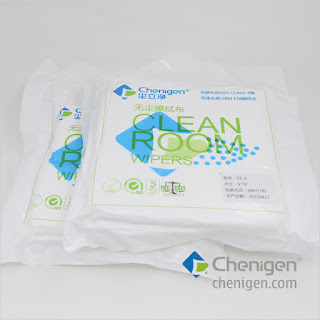Cleanroom wipes are specialized cleaning materials used in controlled environments, such as cleanrooms, where maintaining a high level of cleanliness is crucial. These wipes are designed to minimize the release of particles, fibers, and contaminants during cleaning and are made from materials with low levels of particulate generation.
 |
| Chenigen Cleanroom Wipes |
The primary purpose of cleanroom wipes is to remove and control contamination in sensitive environments. Some key applications of cleanroom wipes include:
Surface Cleaning: Cleanroom wipes are used to clean and wipe down surfaces in cleanrooms, including workstations, equipment, walls, floors, and countertops. They effectively remove particles, dust, oils, and other contaminants without leaving behind residues or generating excessive particles.
Spill Control: In case of spills or leaks of liquids, cleanroom wipes are used to quickly and effectively absorb and contain the spilled substance. They prevent the spread of contaminants and help maintain the cleanliness of the area.
Equipment Maintenance: Cleanroom wipes are employed for cleaning and maintaining delicate equipment within cleanrooms, such as electronic devices, laboratory instruments, and precision machinery. The wipes aid in removing dirt, fingerprints, and other substances that could impact the performance or accuracy of the equipment.
Critical Surface Preparation: Cleanroom wipes are utilized during critical manufacturing processes that require pristine surfaces. They help in preparing surfaces for activities like coating, adhesion, and bonding by removing any impurities that could affect the quality and reliability of the final product.
Personal Cleaning: In certain cleanroom environments, personnel may need to clean themselves to reduce the introduction of contaminants. Cleanroom wipes designed for personal use are used to clean hands, faces, and other exposed areas, ensuring a high level of hygiene.
Cleanroom wipes are available in different materials, such as polyester, microfiber, or nonwoven fabrics, each with specific properties suitable for various cleanroom requirements. They come in various sizes, shapes, and packaging options to accommodate different cleaning tasks and ensure compatibility with the cleanroom standards and protocols.




